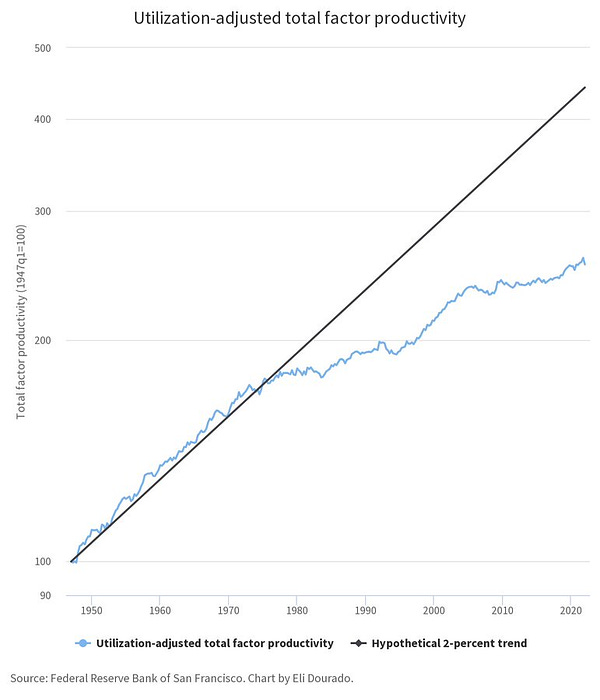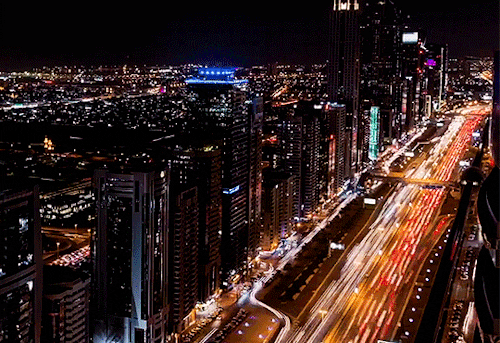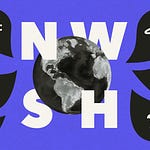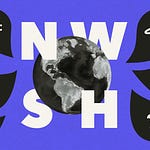Welcome to the mid-week update from New World Same Humans, a newsletter on trends, technology, and society by David Mattin.
If you’re reading this and haven’t yet subscribed, join 22,000+ curious souls on a journey to build a better future 🚀🔮
To Begin
This week’s New Week comes a little late; but it’s a packed instalment.
US energy startup Nuscale Power took a big stride towards the deployment of a revolutionary new kind of nuclear reactor. But where should we all stand on the rise (again) of nuclear?
Meanwhile, AI image generator Midjourney signals the emergence of a new form of creativity. And the life sciences take a Frankenstein’s monster turn via two recent advances.
Let’s get into it. And remember, you can now listen to an audio version of New Week; just scroll up and hit play!
💥 More power
Nuclear power, and the role it should play in our shared future, has roared back on to the global agenda. This week, more news.
The US Nuclear Regulatory Agency certified the first small, modular nuclear reactor. Why is this a big deal? It’s hoped modular reactors can transform our race to decarbonise, because they’re far cheaper and quicker to build than traditional nuclear plants. Oregon-based Nuscale Power’s VOYGR reactor can be mass produced at a central HQ, and then shipped and assembled on-site; the reactor provides enough carbon-free energy to power 60,000 homes.
Nuscale admit that they’re years away from being ready to deploy VOYGR. And they’re racing with other nuclear power startups, including Radiant, to own the space.
Meanwhile, the increasingly acute debate around nuclear — should we lean in or lean out? — found voice in this fascinating Twitter thread:


The author argues that the slow down in real-world (rather than digital) innovation across the last 30 years can be traced back to the neglect or abandonment of nuclear. According to this argument, we deprived ourselves of a near-infinite supply of clean energy and harvested stagnation. It’s an assessment that many leading progress advocates, including Marc Andreessen, share.
⚡ NWSH Take: Some context here: all this comes amid news this week that global use of coal is now expected to return to the record levels set in 2013. We urgently need answers. // But the Twitter thread above taps into the central debate. Should we see reticence around nuclear across the last 30 years as a historic error, and now go all-out to reverse that mistake? Or is nuclear too risky and environmentally disruptive to form the basis of our energy strategy? // Your answer to these questions tends to depend on where you stand on a set of deeper issues. Specifically, issues around growth, the meaning of progress, and the nature of the human wellbeing. Should we remain committed to a path of ever-spiralling material advancement? Or is real progress an acceptance that we should degrow our economies and scale down our energy needs — as one NWSH community member put it, ‘change our mindset and re-think the way we live’?// There is no single right answer. The question reflects two deep, and contradictory, aspects of our nature: the part in all of us that wants to transcend all human and natural limits, and the part that wants to exist in harmony with those limits. The tension between those two impulses will continue to shape the debate on energy, and on the 21st-century more broadly. I’ll be writing more on this soon.
🖼 Machine dreams
This week, new visions from the fast-moving world of AI-generated images.
While most attention has focused on OpenAI’s DALLE-2, others have quietly been building a position. Midjourney is an AI image generator with a difference; it’s accessed via an invite-only Discord community, where users share ideas for text prompts. This week, the startup broadened access; anyone can now set up their own Discord and plug in a Midjourney bot.
The tool has its own distinctive style:
At the heart of Midjourney’s vision, says founder David Holz, is of AI not as a replacement for but as an amplifier of human creativity; Holz calls his creation, ‘an engine for the imagination’.
That’s why, he says, placing the tool in a community context — where people can build and refine on each other’s ideas — is so crucial:
‘If you put people in a group, they’ll go “dog” and someone else will go “space dog” and someone else will go “Aztec space dog,” and then all of a sudden, people understand the possibilities, and you’re creating this augmented imagination — an environment where people can learn and play with this new capacity.’
⚡ NWSH Take: The AI image space is racing right now. Only last month DALLE-2 opened beta access, and Meta showcased its own tool, Make-A-Scene, which allows the user to create a simple sketch that will be enriched by AI. // Midjourney won’t reveal their tech stack, but the tool is almost certainly based on one of the available massive language models, such as GPT-3. But the really interesting aspect of Midjourney isn’t the stack, it’s the vision: of a new form of augmented creativity that sees humans amplified by AI. In this way Midjourney reminds me of Botto, another AI-fuelled art project that attempts an innovative fusion of human and machine intelligence. // We’ve tended to think it would be routine-task jobs that would be disrupted by AI first. The rise of DALLE, Midjourney et al raises a quite different possibility; perhaps it’s human creativity that will be the first domain to be transformed. The images created by Midjourney have a beauty all of their own; jobs such graphic design, illustration, and brand design will surely be revolutionised by these tools in the coming decades. But the possibilities stretch further. It feels, right now, that a new kind of art is taking shape before our eyes. One in which we use machine intelligence to feed our view of the world back to us in strange, defamiliarised, hallucinatory form. NWSH will keep watching.
🔬Dead or alive
This week, two experimental advances offer a glimpse of the revolution being enacted in the life sciences.
Researchers at the Weizmann Institute in Israel announced the world’s first ‘synthetic embryos’, created via mouse stem cells that were made to self-assemble into proto-embryonic structures. In other words, the creation of an embryo without the fertilisation of an egg.
Meanwhile, scientists at Yale University brought the cells of dead pigs back to life. Flooding the bodies of the pigs — which had been dead for an hour — with a nutrient-rich substance caused a reversal of some cell damage, and new cell activity throughout the body. Vital organs, including the heart, liver, and kidneys, began to work again.
The findings, say the scientists, may lead us to question what we mean by dead. Professor Nenad Sestan, lead scientist on the study:
‘The demise of cells can be halted…This progression toward massive permanent cell failure, that does not happen so quickly that it cannot be averted, or possibly corrected…Even one hour after death.’
⚡ NWSH Take: There’s an undeniable Frankenstein’s monster feel to both these experiments. But the work that underlies them could have transformational real-world impacts. Both, for example, could revolutionise organ transplants. Synthetic embryos may eventually allow us to grow new human organs in the lab. Meanwhile, the Yale technique may allow us to keep existing human organs alive for longer, increasing the time window during which transplants are possible. // At the heart of both projects, though, are ethical questions: where are the boundaries between life and death? When is it permissible to create life; when is it permissible to take it away? We’re a long way from the creation of synthetic human embryos. But if our experience of digital innovation across the last two decades has taught us anything, it’s that we need to start thinking through the ethical and social implications of emerging technologies long before they hit the ground. In this case, the time is now.
🗓️ Also this week
👾 A new Danish political party, which used AI to create its policies, says it wants to run in the country’s general election in 2023. The Synthetic Party used AI to analyse the manifestos of all Danish non-mainstream political parties across the last 50 years to create a manifesto that it hopes will appeal to the 15% of eligible Danes who didn’t vote in the 2019 election. The project, which is the creation of digital art collective Computer Lars, says it will run its first public event in September.
🌡 Spain has made it illegal to set air conditioning lower than 27C in public spaces. Offices, shops, bars and theatres are all covered by the new law, which comes into effect at a time of sky-rocketing energy prices in Europe. In other AC news, Bill Gates led a $20 million investment round in clean AC startup Blue Frontier.
👨🏫 Hong Kong University of Science and Technology says it will launch a campus in the metaverse. The institution will launch virtual replicas of its two main physical locations — which are in Hong Kong and Guangzhou — built on a bespoke platform called MetaHKUST. Back in New Week #91 I wrote about the race to simulate real-world locations and experiences in virtual worlds.
💸 A UK citizen wants robots to find the £150 million bitcoin hard drive that he accidentally threw away. James Howells threw the drive away in 2013; he’s now hatched a plan to use robots and AI to scour the landfill site where he believes the drive can be found. But he’s being denied permission by the local council, who say disturbing he landfill will pose an ecological risk.
👨⚕️ A VR environment helped surgeons in Brazil perform surgery to separate twins who were joined at the head. Surgeons in Rio de Janeiro worked alongside surgeons from Great Ormond Street Hospital, London, in the same virtual environment, to perform the 27-hour operation described as ‘one of the most complex separation processes ever completed’.
🚚 Amazon’s latest Sustainability Report shows that its CO2 emissions are accelerating rapidly. Carbon emissions climbed by 18% on 2020 levels, according to the report. In 2019, Jeff Bezos announced that the company would aim for net-zero carbon dioxide emissions by 2040.
🧮 Researchers at MIT used an AI to create new university-level maths problems. When students were presented with a range of maths problems, they were unable to sort those created by the AI from those created by human teachers. The AI can also generate explanations that show how to solve the problems it sets.
🌌 Scientists detected dark matter that existed around galaxies 12 billion years ago — that’s just 2 billion years after the Big Bang. Researchers at Japan's Nagoya University say we’ve never detected the presence of dark matter so soon after the birth of the universe. The work could change our understanding of how galaxies evolved. Dark matter is a mysterious form of invisible matter that, scientists theorise, stops galaxies flying apart. But the question still remains: what, exactly, is it?
🌍 Humans of Earth
Key metrics to help you keep track of Project Human.
🙋 Global population: 7,965,455,247
🌊 Earths currently needed: 1.7862266128
💉 Global population vaccinated: 61.7%
🗓️ 2022 progress bar: 59% complete
📖 On this day: On 6 August 1991 Tim Berners-Lee releases a series of files describing the creation of a World Wide Web.
Infinte Frontier
Thanks for reading this week.
The rising debate around nuclear spans both new technologies and eternal contradictions in our nature. A classic case of new world, same humans.
This newsletter will keep watching, and working to make sense of it all. And there’s one thing you can do to help: share!
Now that you’ve made it to the end of this week’s instalment, why not forward the email to someone who’d also enjoy it? Or share it across one of your social networks, with a note on why you found it valuable. Remember: the larger and more diverse the NWSH community becomes, the better for all of us.
I’ll be back on next week. Until then, be well,
David.
P.S Huge thanks to Nikki Ritmeijer for the illustration at the top of this email. And to Monique van Dusseldorp for additional research and analysis.
















New Week #93